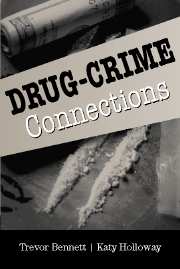Book contents
- Frontmatter
- Contents
- Preface
- Acknowledgments
- PART ONE INTRODUCTION
- PART TWO DRUG MISUSE AMONG CRIMINALS
- PART THREE DRUG-CRIME AFFINITIES
- PART FOUR SPECIAL TOPICS
- 9 Gender, Drugs, and Crime
- 10 Ethnicity, Drugs, and Crime
- 11 Gangs and Gang Members
- 12 Gun Possession and Use
- 13 Drug Markets
- 14 Assisted Desistance and Treatment Needs
- 15 International Comparisons
- PART FIVE CONCLUSIONS
- References
- Index
11 - Gangs and Gang Members
Published online by Cambridge University Press: 18 December 2009
- Frontmatter
- Contents
- Preface
- Acknowledgments
- PART ONE INTRODUCTION
- PART TWO DRUG MISUSE AMONG CRIMINALS
- PART THREE DRUG-CRIME AFFINITIES
- PART FOUR SPECIAL TOPICS
- 9 Gender, Drugs, and Crime
- 10 Ethnicity, Drugs, and Crime
- 11 Gangs and Gang Members
- 12 Gun Possession and Use
- 13 Drug Markets
- 14 Assisted Desistance and Treatment Needs
- 15 International Comparisons
- PART FIVE CONCLUSIONS
- References
- Index
Summary
INTRODUCTION
There is growing debate in the United Kingdom on the number and nature of street gangs and their contribution to crime and violence. However, the discussion is impeded to some extent by a lack of agreement on the definition of what constitutes a gang. Confusion over definitions of gangs is not confined to the United Kingdom. Klein (2001) argued that the concept of gangs in the United States has been shaped by the stereotype of the West Side Story gang and the image of gang ‘colors’. He argued that both are distortions of reality, and that few American gangs fit this stereotype. He argues instead that gang formations are much more variable and proposes a typology of observable gang structures based on five discrete forms (traditional, neo-traditional, compressed, collective, and specialty). Decker (2001) argued that the concept of the gang has been distorted by the dominance of the view that gangs are well organized and tightly structured. However, an alternative view, supported by his own research, shows that gangs are often disorganized and typically do not have leaders.
It is not necessary to enter into the complexities of this debate in this chapter because it has been discussed at length elsewhere (see Klein et al., 2001, for an overview). However, it is worth noting that the aim of this chapter is to investigate what are typically called ‘street gangs’ (Klein, 2001) or ‘youth gangs’ (Sanders, 1994) rather than ‘criminal gangs’ or ‘crime firms’ that come together solely to commit a particular criminal act and then disperse.
- Type
- Chapter
- Information
- Drug-Crime Connections , pp. 211 - 233Publisher: Cambridge University PressPrint publication year: 2007

